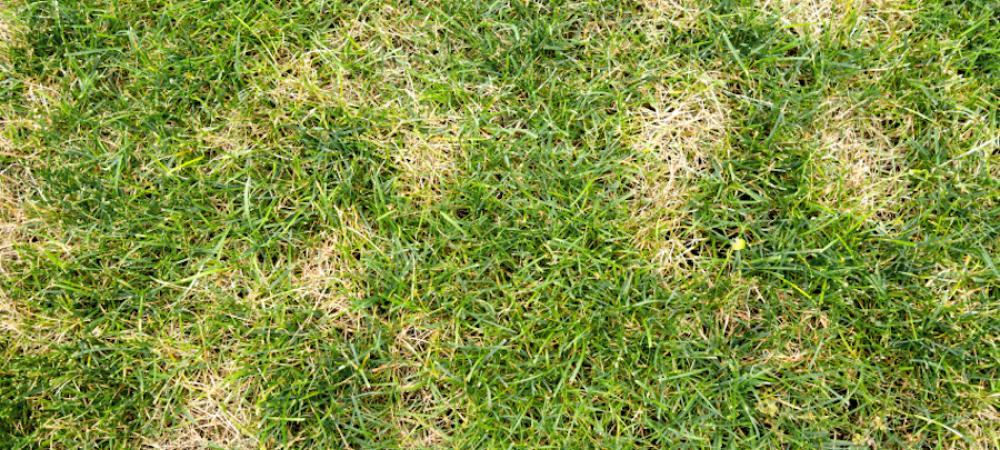How to Spot Dollar Spot Fungus

Dollar spot fungus is a common and notorious lawn disease that affects grass, especially in Florida. This fungal disease is caused by the pathogen Sclerotinia homoeocarpa. It is known for its distinct symptom of small, circular, straw-colored spots on the grass blades, which resemble silver dollars.
In Florida, the warm and humid climate provides ideal conditions for the dollar spot fungus to thrive, making it a prevalent issue for lawn care. The disease typically occurs in the spring and fall when the temperatures are cooler and the humidity is high.
Preventive measures for dollar spot fungus include proper lawn care practices such as regular mowing, adequate fertilization, and proper watering techniques to promote a healthy and strong lawn that is more resistant to the disease. Additionally, certain types of grass, such as bentgrass, fine fescue, and perennial ryegrass, are more susceptible to dollar spot fungus and may require extra attention and care.
Identifying Dollar Spot Symptoms
Recognizing the symptoms of dollar spot is crucial in order to take appropriate measures to control and manage the disease. By understanding the signs of dollar spot, lawn and turf managers can prevent the spread of the disease and maintain the health and appearance of the grass. Identifying dollar spot symptoms involves looking for distinctive straw-colored or bleached patches of grass that are roughly the size of a silver dollar, hence the name "dollar spot." In addition, close examination may reveal small, tan lesions on the grass blades and a characteristic hourglass-shaped lesion at the base of the blade. Understanding and recognizing these symptoms is essential for effective disease management and maintaining the overall health and appearance of turfgrass.
Thin, silver dollar-sized spots on grass blades
Thin, silver dollar-sized spots on grass blades are a classic symptom of dollar spot disease in turfgrass. These lesions often have an “hourglass” shape and are caused by the fungus Clarireedia jacksonii. When dealing with this symptom, it is important to take immediate action to prevent the spread of the disease. Proper fungicide applications and high-maintenance irrigation practices are recommended steps for addressing dollar spot disease. It is crucial to control this disease, especially on golf courses, where the appearance and health of the turfgrass is essential. Frequent fungicide applications can result in significant costs, so early detection and effective management are key in preventing the spread of dollar spot disease. Therefore, regular inspection and proactive measures should be taken to maintain the health and appearance of turfgrass and prevent the spread of dollar spot disease.
White mycelium visible in early morning dew
In the early morning dew, white mycelium can be seen spread across the forest floor, particularly in areas of high moisture and shade. The mycelium appears as thin, web-like strands that glisten with the dew, creating a mesmerizing and delicate pattern across the ground. Its size can vary, with some patches only a few inches in diameter while others stretch several feet.
The mycelium has a soft, cotton-like texture and blends in seamlessly with the surrounding environment. Its presence indicates the activity of fungi underground, functioning as the main organism of the fungi kingdom. While it may not have a direct impact on plant life visible to the naked eye, the mycelium plays a crucial role in nutrient cycling, as it breaks down organic matter and assists in the absorption of water and nutrients by plant roots. Furthermore, it also fosters symbiotic relationships with certain plant species, aiding in their growth and overall health.
Assessing the Severity of Dollar Spot Infection
Dollar spot infection is a common fungal disease that affects both golf courses and home lawns, causing significant damage to turfgrass. Assessing the severity of dollar spot infection is crucial in order to implement the appropriate management strategies. By carefully evaluating the extent of the infection, lawn and turf managers can determine the best course of action to minimize the damage and promote recovery. Various factors such as environmental conditions, turfgrass variety, and the level of maintenance can all contribute to the severity of dollar spot infection. Understanding the specific indicators of the infection's severity is essential in crafting an effective plan to control and prevent further spread of the disease. This article will discuss the key aspects of assessing the severity of dollar spot infection and provide insights into effective management strategies for controlling this damaging fungal disease.
When to call a professional lawn care company
Dollar spot fungus is a common lawn disease that can quickly spread and cause extensive damage to the grass. If left untreated, it can result in unsightly brown patches and thinning of the turf. While some homeowners may attempt to address dollar spot fungus on their own by adjusting watering and fertilization practices, in severe cases, it may be necessary to call a professional Bradenton lawn care company.
At Southern Greens Pest Control, we have the expertise and specialized equipment to diagnose and treat dollar spot fungus properly. Our technicians can apply fungicides to effectively control the spread of the disease and restore your lawn's health and appearance. Additionally, we can provide ongoing maintenance and monitoring to prevent future fungus outbreaks. Contact us today to learn more.
